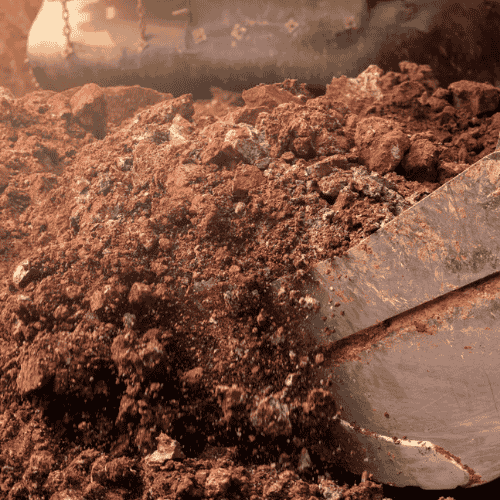
If you’ve ever walked into a landscaping supply yard or started a garden renovation project, chances are you’ve heard the terms fill dirt and topsoil. While they may sound like interchangeable types of dirt, they serve very different purposes. Using the wrong one in the wrong spot could cost you time, money, and a lot of headaches later on.
So, what is the actual difference between fill dirt and topsoil? Let’s dig in and uncover how each type of soil functions, when to use them, and why it matters—especially here in New Jersey.
Understanding Fill Dirt
What Is Fill Dirt?
Fill dirt is a type of earthy material made primarily of subsoil—meaning it’s located beneath the topsoil layer. It contains very little organic matter and is composed mostly of sand, clay, and small rocks.
This type of soil is not meant to support plant growth. Instead, its primary job is to provide stability. It’s often used to fill in holes, create elevation, or form a strong foundation before laying concrete, stone, or sod.
Common Uses for Fill Dirt:
- Backfilling around foundations
- Leveling land for hardscaping
- Raising low spots in a yard
- Creating berms or slopes
- Underneath retaining walls or patios
In construction and landscaping, fill dirt is essentially the go-to choice when you need to build up land or provide a compactable base.
What Is Topsoil?
Topsoil, on the other hand, is the uppermost layer of soil—usually the first 5 to 12 inches. It’s rich in nutrients, contains decomposed organic matter (humus), and is teeming with beneficial microbes. It’s the lifeblood of any successful garden or landscape because it supports healthy root growth.
Key Features of Topsoil:
- High in nutrients
- Supports plant and lawn growth
- Darker in color due to organic content
- Looser texture, ideal for aeration and drainage
Common Uses for Topsoil:
- Lawn repair and reseeding
- Flower beds and vegetable gardens
- Raised beds
- Landscape grading (top layer only)
- Mulching and weed prevention (when used with compost)
If you’re planting anything, from grass to shrubs, you’ll need topsoil.
Why Knowing the Difference Matters
Mixing up fill dirt and topsoil is more common than you might think—and it can lead to costly mistakes. For example:
- Using fill dirt instead of topsoil in garden beds can result in poor plant health, slow growth, or complete failure to grow.
- Using topsoil to fill deep holes or grade a slope can lead to settling, erosion, or unstable surfaces.
That’s why understanding the composition and purpose of each soil type is crucial, especially for homeowners, contractors, and property managers in New Jersey’s varying terrain.
NJ Landscaping Tip: Layer Strategically
If your project involves both stability and planting, you may actually need both fill dirt and topsoil. Start with fill dirt to level or shape the area, compact it down, and then layer topsoil on top to support plant life.
For example, if you’re installing a new lawn on uneven ground:
- Grade and fill low spots with fill dirt.
- Compact the surface to prevent future settling.
- Add 3–6 inches of topsoil.
- Seed, fertilize, and water.
This layering technique creates a stable base with a nutrient-rich growing environment on top.
How to Tell Fill Dirt from Topsoil
If you’re not sure what kind of dirt you’re looking at, here’s how to tell the difference:
| Feature | Fill Dirt | Topsoil |
|---|---|---|
| Color | Light brown, tan, or gray | Dark brown to black |
| Texture | Dense, heavy, may contain rocks | Loose, crumbly, organic matter |
| Smell | Neutral or clay-like | Earthy, rich smell |
| Plant Readiness | Not suitable | Ideal for planting |
Still unsure? When in doubt, talk to a local soil supplier—like Kirk Allen Landscape Supply—to get expert advice on the right material for your job.
Where to Get Quality Fill Dirt & Topsoil in NJ
If you’re located in Sussex County or the surrounding New Jersey area, Kirk Allen Landscape Supply offers high-quality screened fill dirt and topsoil delivered straight to your home or job site. Whether you’re starting a backyard garden or prepping a construction project, we’ve got the right soil for your needs.
Why Choose Us?
- Locally sourced material
- Screened for rocks and debris
- Competitive pricing
- Delivery available throughout NJ
Need help deciding how much you’ll need? Give us a call at 973-347-3117 and our team will walk you through the calculation based on square footage and depth.
Fill Dirt and Topsoil FAQs
Q: Can I use fill dirt to grow grass?
A: No, fill dirt lacks the nutrients and structure needed to support plant life. You need at least a few inches of topsoil for grass to thrive.
Q: Can I mix fill dirt and topsoil together?
A: You can blend them in some situations, but for planting, it’s best to use topsoil as the upper layer.
Q: How much topsoil do I need for my lawn?
A: For new lawns, you generally need 4–6 inches of topsoil. For topdressing or overseeding, 1–2 inches may be enough.
Q: Is topsoil good for drainage?
A: Yes, especially loamy topsoil with good structure. Avoid overly clay-heavy blends if drainage is a concern.
Final Thoughts
When it comes to landscaping success, the foundation matters—literally. Fill dirt gives you the stability to shape your land, while topsoil brings it to life. Knowing which to use and where can make all the difference in how your outdoor project looks and functions over time.
If you’re working on a yard, garden, or construction project in New Jersey, trust Kirk Allen Landscape Supply for premium-grade soil delivered with expert care. Call us at 973-347-3117 or visit kirkallenlandscapesupply.com to get started.

